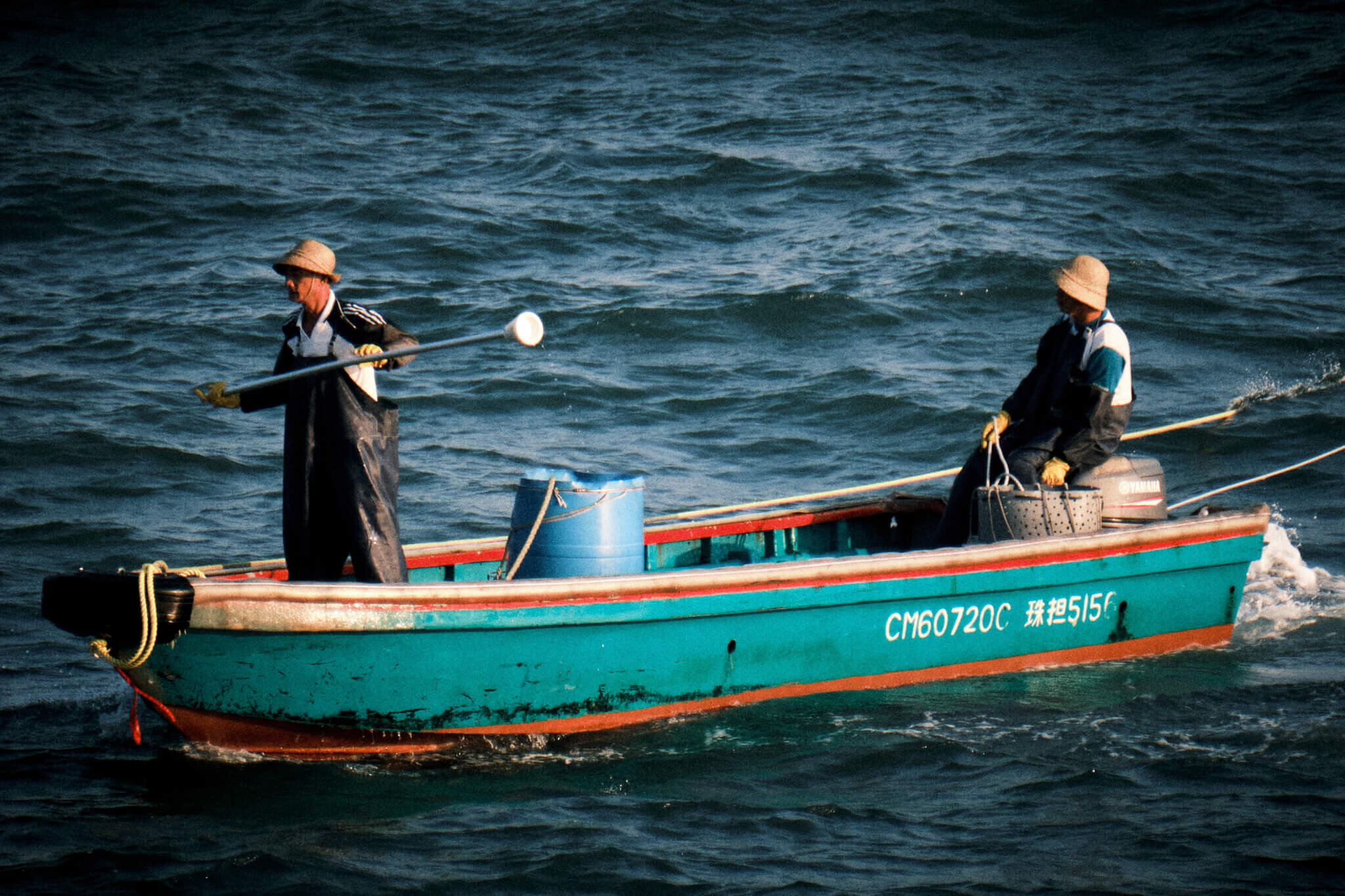Cheung Chau, in Hong Kong, may be one of the best places on earth to live. Beaches and verdant forest jungle, down to beautiful rock formations plunging into an ever-changing blue green sea. People have lived here for a couple thousand years, as evidenced by our famous beautiful petroglyphs. The large natural harbour and the bounty of the sea made for a good life, in hunter/fisher-gatherer days.
Dan Carew, "Cheung Chau Fisher People 47,” Cheung Chau, 2020
Dan Carew, "Cheung Chau Fisher People 07,” Cheung Chau, 2020
Dan Carew, "Cheung Chau Fisher People 27,” Cheung Chau, 2020
Dan Carew, "Cheung Chau Fisher People 19,” Cheung Chau, 2020
Dan Carew, "Cheung Chau Fisher People 07,” Cheung Chau, 2020
Dan Carew, "Cheung Chau Fisher People 09,” Cheung Chau, 2020
Up until 20 years ago, turtles laid eggs on Cheung Chau’s beaches. And there are still snakes, birds, crabs and clams in abundance. Nowadays the work of fishing is hard physical work, as fish are a commodity and the catches yield less because of overfishing and pollution. For the last 10 years a pastime of mine has been watching in wonder the fisher people of Cheung Chau and their magnificent boats from my bedroom balcony, on a cliff overlooking the sea to the south of Cheung Chau. These are fertile fishing grounds. Local Cheung Chau-ers (mostly older folk including many women) fish here. But also larger boats from China, with crews of grizzled middle-aged men. The folks from China might be cousins, from the visible nearby islands of China, Erzhou Dao and Wailing Ding Dao.
Dan Carew, "Cheung Chau Fisher People 51,” Cheung Chau, 2020
Dan Carew, "Cheung Chau Fisher People 04,” Cheung Chau, 2020
Dan Carew, "Cheung Chau Fisher People 14,” Cheung Chau, 2020
Dan Carew, "Cheung Chau Fisher People 32,” Cheung Chau, 2020
Dan Carew, "Cheung Chau Fisher People 08,” Cheung Chau, 2020
Dan Carew, "Cheung Chau Fisher People 29,” Cheung Chau, 2020
Dan Carew, "Cheung Chau Fisher People 43,” Cheung Chau, 2020
A couple years ago I bought a long telephoto lens (full frame equivalent of 300-1200mm) for my Fujifilm camera, to document this way of life. At first, I was focused on the beautiful brightly-coloured boats. But when I closely examined the photos and zoomed in, it was always the people, the fisher people that drew me in. Hard at work, with efficient and paced muscle-memory movements. Or gazing out to sea. Washing, keeping house, chatting. We live in precarious times, and with climate change, this way of life may soon be over. But for now, there still are these vital fisher people, whose lives on their vessels few get to see. Enjoy.
Dan Carew, "Cheung Chau Fisher People 53,” Cheung Chau, 2020
Dan Carew, "Cheung Chau Fisher People 03,” Cheung Chau, 2020
Dan Carew, "Cheung Chau Fisher People 07,” Cheung Chau, 2020
香港的長洲,可能是世界上最好的地方。碧綠海灘、翠綠森林、巨型岩石及無邊海洋。兩千多年前,已有人在此定活,一些著名岩畫可作証。天然港口,海洋產物為漁家帶來豐富物資及好生活。直至20 年前,海龜還會在長洲海灘產卵呢。時致今日,還有很多蛇、鳥居住在長洲,海洋生物也很豐盛。現今世代,捕魚是比較勞動工作,魚是商品。但由於過度捕獵及污染,魚獲減少。 過往十年,我時常在家露台觀望海上漁船及漁民工作。那是長洲以南水域,魚產甚豐。本地長洲人 (年長一輩,包括女魚民)在這裏捕魚。但也有一些比較大的中國船,由中年男船員航行,可能是由中國二洲島和外伶仃島來的。 大約兩年前,我買了一個長焦距鏡頭 (全片幅300-1200毫米)用在我的Fujifilm 相機,去紀錄這些生活。最初,我専注在色彩鮮艷的船集。但當我細心觀察及放大相片,每每都是人,漁民吸引着我:辛勤勞動,熟練動作,遠望大海,洗衣服,收拾船上物品,談天。我們在這不穏時代及面對氣候變化,這種生活方式可能有完的一天。但現在,我們也能看見和欣賞漁民漁船的生活點滴。希望你會喜歡。
Dan Carew, "Cheung Chau Fisher People 48,” Cheung Chau, 2020
Dan Carew, "Cheung Chau Fisher People 37,” Cheung Chau, 2020
Dan has lived 35 years in Asia (Taiwan, Japan, Hong Kong), having grown up mostly in the U.S. He’s taken photos from a young age and was influenced by his mother, a painter. Got trained in the darkroom with monochrome film at 10 years old. Bought his own first (film) camera, a used Olympus OM-1 with 50mm lens, on Nathan Road in 1983. With that camera in the ‘80’s, he took coloured slides in Nicaragua, Europe and China. Between then and now, he’s made a living as a seaman on a tanker ship, a secondary school history teacher for students in Harlem NYC, developing financial software, as a technologist for big global brands and briefly running a boutique digital cinema services company. He also tried his hand briefly at filmmaking and selling sailboats. In the last few years, he has been working seriously on his photography (including winning a prize in a Ricoh photography contest in 2020). Dan lives with his wife and children on Cheung Chau.
Dan 在美國長大,隨後在亞洲生活達35 年 (台灣,日本,香港)。 他從小已喜歡拍攝照片,主要受作為畫家的母親影響。他在十歲時,在黑房內學習單色冲印。1983 在彌敦道買了他第一部相機,一部二手Olympus OM-1 50毫米鏡。80 年代,那部相機陪伴他在尼加拉瓜,歐洲及中國拍攝彩色照片。之後,他當過油船船員、在紐約哈林區當中學歷史老師、在日本建設財務系統、在香港任職國際公司科技顧問及曾經運作一間小型數碼電影公司。 他也曾嘗試過製作電影及賣帆船。近年,他認真地投入攝影 (包括在 Ricoh 2020 攝影比賽中獲獎)。Dan 現與妻子及其小孩居於長洲。
https://www.instagram.com/dan.carew/
Contact here if you are interested in purchasing work by the artist and we will help connect you.




















